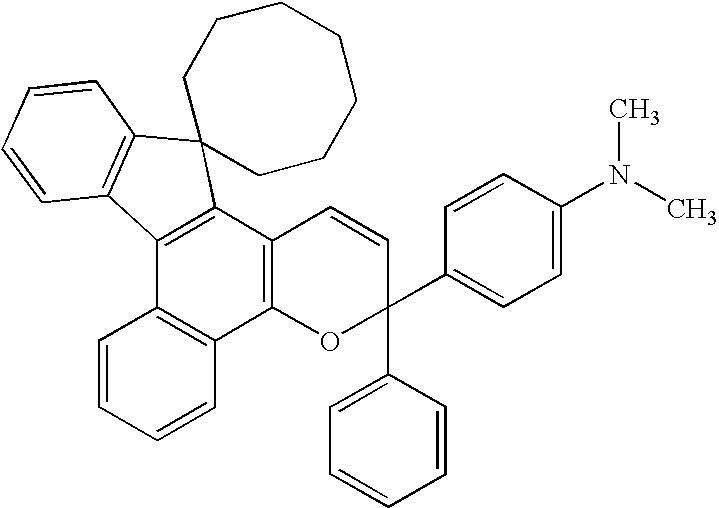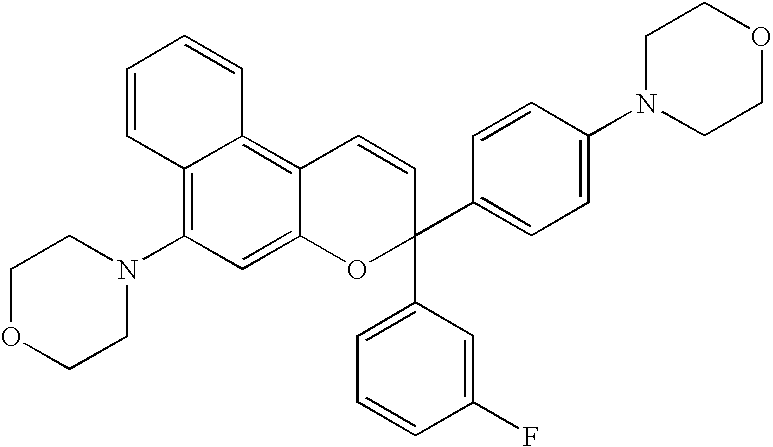Photochromic multilayer body and method for producing same
- Summary
- Abstract
- Description
- Claims
- Application Information
AI Technical Summary
Benefits of technology
Problems solved by technology
Method used
Image
Examples
example 1
[0097] As a base material of lens, there was used a polycarbonate lens material. A photocurable hard coating agent “UVHC1105” (content of colloidal silica: 30% by weight) produced by GE Toshiba Silicone Co. was applied as a curable primer composition (primer solution) onto the surfaces of the base material by the spin-coating method by using a spin coater 1H-DX2 manufactured by MIKASA Co., such that the film thickness was 2 μm. Thereafter, the curable primer composition was half-cured by being irradiated with light from a 120-watt metal halide lamp in a nitrogen atmosphere for 2 minutes to prepare a lens material having a primer coating in the half-cured state containing colloidal silica in an amount of 30% by mass. Properties of the thus obtained primer coating were evaluated by the methods described below.
(a) Evaluation of the Conversion.
[0098] The lens material having the primer coating in the half-cured state was immersed in methylene chloride for two days to extract the unre...
example 2
[0112] A photochromic laminate was produced by forming a photochromic coating on the surfaces of a lens material via the crosslinked resin layer in the same manner as in Example 1 with the exception of using, as the primer solution, a photocurable hard coating agent “UVHC8558” produced by GE Toshiba Silicone Co. to form a crosslinked resin layer containing 30% by weight of colloidal silica. The laminate was evaluated for its properties in the same manner as in Example 1.
[0113] The composition of the curable primer composition and the half-curing condition were as shown in Table 1, the composition of the photochromic agent composition and the pretreating conditions were as shown in Table 2, and the conversion of the primer coating, and evaluated results of properties of the primer coating and of the photochromic layer were as shown in Table 3.
examples 3 to 18
[0114] Photochromic laminates were produced in the same manner as in Example 1 but using the photochromic agents of the compositions shown in Table 2 instead of using the curable primer composition and curing conditions shown in Table 1. The laminates were evaluated for their properties in the same manner as in Example 1.
[0115] The compositions of the curable primer compositions and the half-curing conditions were as shown in Table 1, the compositions of the photochromic agent compositions and the pretreating conditions were as shown in Table 2, and the conversion of the primer coatings, and evaluated results of properties of the primer coatings and of the photochromic layers were as shown in Table 3.
PUM
| Property | Measurement | Unit |
|---|---|---|
| Temperature | aaaaa | aaaaa |
| Temperature | aaaaa | aaaaa |
| Time | aaaaa | aaaaa |
Abstract
Description
Claims
Application Information
 Login to View More
Login to View More - R&D
- Intellectual Property
- Life Sciences
- Materials
- Tech Scout
- Unparalleled Data Quality
- Higher Quality Content
- 60% Fewer Hallucinations
Browse by: Latest US Patents, China's latest patents, Technical Efficacy Thesaurus, Application Domain, Technology Topic, Popular Technical Reports.
© 2025 PatSnap. All rights reserved.Legal|Privacy policy|Modern Slavery Act Transparency Statement|Sitemap|About US| Contact US: help@patsnap.com



